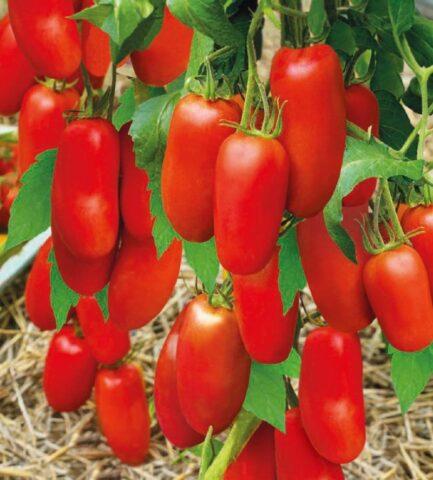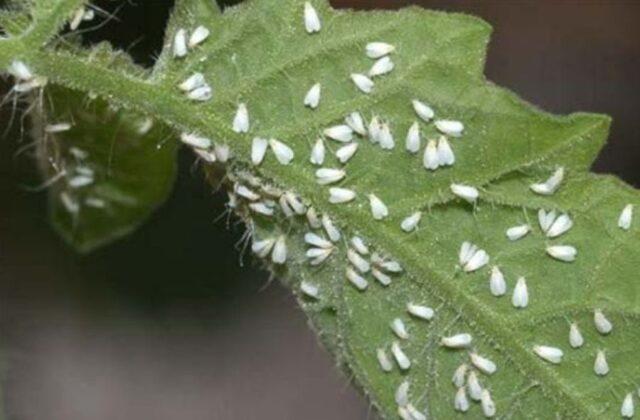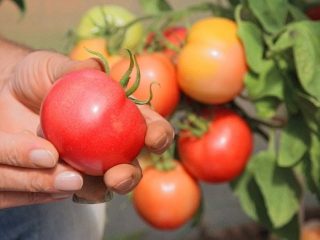Content
Tomato Sterlet is a productive and tasty tomato variety with good hardiness. Before planting a crop on a site, you need to study the characteristics of the variety and requirements for cultivation.
History of origin
Very little information is known about the origin of the Sterlet tomato. The originator is the Altai Seeds brand, which supplies planting material to the market. The prefix F1 in the name indicates that the tomato belongs to the category of hybrids, but there is also no information about the parent varieties.
Description of the tomato variety Sterlet
Tomato Sterlet F1 is a determinate variety and grows on average up to 80 cm above the ground. Forms a compact bush with a strong and thick stem; the leaf plates of the plant are bright green, of a traditional shape for the crop. During the growing season, it forms up to 5-6 inflorescences, with the first cluster formed above the 8-9 leaf, and then the flowers follow through two leaves.

The Sterlet tomato is equally suitable for growing in the ground and in a greenhouse
In terms of ripening time, the variety is early ripening; the harvest can be harvested already 94 days after the formation of green shoots. Tomato fruits are elongated, beautiful and neat, with an average weight of 150 g. The tomato skin is dense and smooth, shiny, the flesh is deep red. The variety is distinguished by good juiciness and sweet taste with pleasant sourness.
Characteristics of tomato Sterlet
Before planting a Sterlet tomato on a site, you need to study its main characteristics. These include fruiting indicators, as well as the degree of endurance of the variety and area of application.
Productivity of tomato Sterlet
The hybrid tomato variety is characterized by good yield indicators. From a square meter of plantings you can collect up to 6.5-7.5 kg of juicy ripe fruits. At the same time, the yield of the variety depends on the growing conditions - in a greenhouse, tomato bushes form ovaries more actively than in open ground.
Resistance to diseases and pests
Tomato Sterlet has average immunity to fungal diseases and pests. The variety rarely suffers from fusarium, verticillium and various blights. Late blight poses a low threat to tomatoes. The disease most often develops by August, and Sterlet manages to finish fruiting earlier.
At the same time, bad weather conditions and improper agricultural practices have a negative impact on the health of tomato bushes. The Sterlet tomato can suffer from root rot and viral diseases when the soil is waterlogged or excessively acidified.

It is recommended to treat the soil with fungicides before planting Sterlet tomato
Methods of use
The hybrid tomato variety Sterlet has good shelf life and is suitable for transportation for sale. When grown for personal purposes, tomatoes are most often used in salads and canning. The small, dense fruits are not prone to cracking and retain their shape well when rolled into jars. If desired, tomatoes can be dried for the winter or stewed and baked along with other products.
Advantages and disadvantages
Before planting a Sterlet tomato, it is necessary to study both the strengths and weaknesses of the variety. This will help you understand what points you need to pay special attention to when growing.
Pros: · good productivity; · the fruits ripen together; · tomatoes do not crack and are stored for a long time; · versatility of application; · good immunity against diseases; · Can grow in greenhouse conditions and in open soil. | Minuses: · reacts sensitively to the degree of soil moisture; · the hybrid cannot be propagated with its own seeds; The fruits are small in size. |
In general, the Sterlet tomato is considered an easy-to-grow hybrid. Summer residents especially note the fact that the low-growing plant does not require the installation of high trellises, like many other varieties.
Agricultural technology of tomato Sterlet
Hybrid tomato Sterlet has standard care requirements. The variety is grown in seedlings, the algorithm looks like this:
- At the end of March or early April, hybrid tomato seeds are soaked in a disinfectant solution of potassium permanganate, and then dried from moisture.
- A shallow container is filled with nutritious soil with the addition of humus and compost.
- The seeds are sown in small furrows no deeper than 1.5 cm, sprinkled with soil and moistened with a spray bottle.
- Until greenery appears, the box under film or glass is kept at a temperature of about 27 ° C under diffused lighting.
After sprouts form, the seedlings are moved to a sunny windowsill and the cover is removed. After about two weeks, the seedlings dive into separate cups. Planting in the ground is carried out in May or early June; until this time, the seedlings are regularly moistened.

Before transferring to open ground, Sterlet tomato seedlings are hardened off for ten days
Planting the Sterlet tomato in open ground is carried out in a well-lit area with cover from strong winds. Leave 20 cm of free space between individual plants and rows.
Caring for a Sterlet tomato in open ground comes down to several procedures:
- Watering. The bushes are moistened as needed 2-3 times a week; the soil should not dry out, but waterlogging should not be allowed.
- Feeding. During the entire growing season, the Sterlet tomato is fertilized 4-5 times at intervals of an average of two weeks. It is necessary to use a solution of mullein or bird droppings with the addition of wood ash. Bushes especially need feeding during the formation of ovaries and at the beginning of fruit ripening.
- Stepsonning. It is recommended to grow the Sterlet tomato in 2-3 stems; side shoots are removed after they reach 3-5 cm.
A low-growing variety of tomatoes does not require a garter. But if you wish, you can install supports next to the bushes so that the stems do not bend to the ground under the weight of the fruit.
Pest and disease control
Tomato Sterlet is immune to some dangerous diseases. But other fungi and pests still pose a threat to it:
- anthracosis - black dots and soft depressed areas appear on ripening tomatoes;
The drugs Topaz and Quadris help well against anthracnose
- black leg - the disease develops in conditions of waterlogging, the bushes rot at the base of the stem and lie down;
Blackleg cannot be treated, but loosening the soil and monitoring watering helps prevent the disease.
- aphids - large colonies of insects are capable of eating up tomato plantings;
A regular soap solution works well against aphids.
- whitefly - pest larvae settle on the lower surface of leaves and suck out plant sap;
The drug Iskra helps get rid of whiteflies
- thrips are small mosquito-like insects that feed on crop fruits and transmit viral infections.
The fight against thrips is carried out with the drugs Biotlin and Aktara
Not all diseases of Sterlet tomato are treatable. To prevent damage by fungi and pests, it is recommended to pay special attention to the pre-sowing treatment of seeds in a solution of potassium permanganate. During cultivation, you should loosen the soil under the bushes after each watering and prevent the soil from becoming waterlogged.
Conclusion
Tomato Sterlet is a productive and quite hardy variety, intended for growing outdoors and in a greenhouse. The bushes have standard care requirements; it is important to provide the tomatoes with moderate moisture and regular feeding.
Reviews from gardeners about the Sterlet tomato














Hello. I've been gone for a long time. Tomatoes grow in exhaust gas, but under cover. It was raining, so I think he had enough moisture. But now they have a lot of stepchildren and they are already big. Should I leave it like this or should I still cut it? Of course, it will no longer be possible to form into 3 stems. Maybe the leaves should be trimmed at the bottom and that’s it? Please tell me.
Good afternoon.
We urgently need to trim the shoots and feed the tomatoes. Trim stepsons according to the following rules:
• remove all small stepchildren;
• cut off the leaves at the bottom of the bush;
• cut off large stepsons if they have no ovaries;
• leave 2-3 largest stepsons (if you grow tomatoes in 2-3 trunks).
After trimming tomatoes, you must:
• water;
• feed with phosphorus-potassium fertilizers;
• spray the bushes with boric acid.